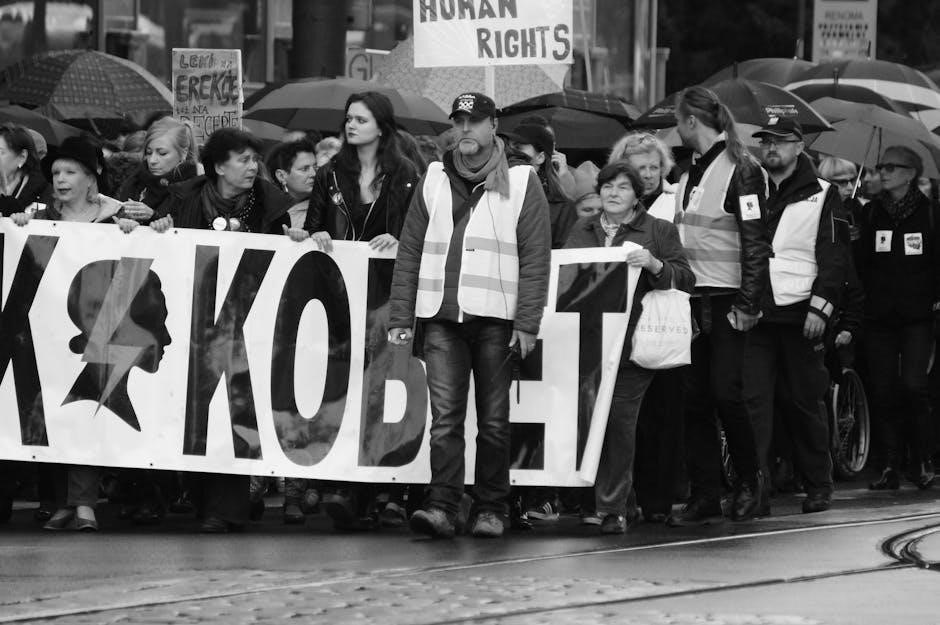Situational awareness is crucial for workplace safety, enabling employees to perceive and comprehend their environment effectively, preventing accidents. Toolbox talks provide short, focused discussions to enhance this skill.
1.1 Definition of Situational Awareness
Situational awareness (SA) is the ability to perceive, comprehend, and project environmental factors to understand a situation accurately. It involves recognizing entities, their meanings, and anticipating future states. In workplace safety, SA is vital for identifying hazards and preventing incidents. Toolbox talks often emphasize SA as a critical skill to enhance safety culture and proactive risk management.
1.2 Importance of Situational Awareness in Workplace Safety
Situational awareness is essential for workplace safety as it enables employees to identify potential hazards promptly. By staying alert to their surroundings, workers can prevent accidents and ensure a safer environment. Toolbox talks highlight SA’s role in proactive risk management, fostering a culture of safety and reducing incident rates across industries. Enhanced SA leads to better decision-making and improved overall safety outcomes.
1.3 Brief Overview of Toolbox Talks
Toolbox talks are short, informal discussions focused on specific safety topics, including situational awareness. Led by supervisors, they provide practical insights and real-life scenarios to enhance workplace safety. These talks are designed to engage employees, promote a safety culture, and ensure continuous improvement. By addressing topics like hazard identification and risk management, toolbox talks play a key role in maintaining a safe and proactive work environment.

Key Components of Situational Awareness
Situational awareness involves perceiving the environment, understanding its factors, and projecting future states to anticipate risks and make informed decisions.
2.1 Perception of the Environment
Perception of the environment is the foundation of situational awareness, involving the ability to accurately recognize and interpret physical and contextual elements. This includes identifying potential hazards, understanding spatial relationships, and staying attuned to changes. By remaining vigilant and using sensory inputs, individuals can gather critical information about their surroundings, enabling them to make informed decisions and maintain safety. This step is essential for detecting risks early and preventing incidents.
2.2 Comprehension of Environmental Factors
Comprehension of environmental factors involves interpreting and understanding the significance of perceived elements within a setting. This includes analyzing how different factors interact and their potential impact on safety. By grasping the meaning of environmental cues, individuals can identify potential hazards, anticipate risks, and take proactive measures. This step enhances the ability to make informed decisions, ensuring a safer and more controlled environment for everyone involved.
2.3 Projection of Future Status
Projection of future status involves predicting how the environment and its elements may change over time. This aspect of situational awareness requires forecasting potential developments, such as emerging hazards or evolving situations. By anticipating future states, individuals can prepare for likely scenarios, adjust their actions, and mitigate risks proactively. This forward-thinking ability is essential for maintaining safety and efficiency in dynamic and unpredictable environments.
Methods to Enhance Situational Awareness
Situational awareness can be enhanced through strategies like the Stop, Think, and Act method, using checklists, and conducting regular training drills. These practices promote proactive safety.
3.1 Stop, Think, and Act Strategy
The Stop, Think, and Act strategy encourages employees to pause before performing tasks, assess risks, and take deliberate actions. This method promotes mindful decision-making, reducing workplace accidents by fostering a proactive approach to safety. Regular training and drills reinforce this strategy, ensuring it becomes second nature for teams, enhancing overall situational awareness.
3.2 Use of Checklists and Visual Aids
Checklists and visual aids are powerful tools for enhancing situational awareness. They simplify complex information, ensuring tasks are completed safely and efficiently. Visual aids like diagrams or flowcharts help employees quickly identify potential risks, while checklists provide a structured approach to assessing environments. These resources are particularly effective in high-stress situations, where clear guidance is essential. Regular use of these tools fosters a culture of preparedness and attention to detail.
3.3 Role of Training and Drills
Training and drills play a vital role in improving situational awareness by equipping employees with practical skills and knowledge. Regular exercises simulate real-life scenarios, helping teams anticipate and respond to potential hazards. These sessions foster a proactive mindset, ensuring that safety protocols are second nature. Continuous training also adapts to evolving workplace conditions, keeping situational awareness sharp and relevant. Drills reinforce learning, making employees more adept at identifying risks and taking appropriate actions swiftly.
Situational Awareness in High-Risk Environments
Situational awareness is critical in high-risk environments to prevent incidents. It ensures quick identification of hazards, enabling timely responses to maintain safety and minimize risks effectively.
4.1 Aviation and Emergency Medical Dispatch Examples
In aviation, situational awareness ensures pilots monitor surroundings, anticipate risks, and make informed decisions swiftly. Similarly, emergency medical dispatchers rely on it to assess situations accurately and allocate resources efficiently. Both fields highlight the importance of staying alert and proactive; Enhanced avionics and training drills further improve these capabilities, reducing errors and enhancing safety outcomes significantly in high-pressure environments. Proper use of checklists also aids in maintaining focus during critical operations.
4.2 Construction and Manufacturing Industry Applications
Situational awareness is vital in construction and manufacturing, where hazards like heavy equipment, moving parts, and dynamic environments pose constant risks. Toolbox talks emphasize recognizing potential dangers, such as equipment malfunctions or unsafe conditions, to prevent accidents. Techniques like STOP, THINK, ACT encourage workers to assess situations before acting. Regular training and checklists further enhance awareness, ensuring a safer workplace and reducing incidents. These practices are essential for protecting both personnel and assets.
4.3 Behaviour-Based Safety (BBS) Techniques
Behaviour-Based Safety (BBS) techniques focus on identifying and reinforcing safe behaviours through observation and feedback. By encouraging workers to observe and correct unsafe actions, BBS fosters a proactive safety culture. These techniques complement situational awareness by addressing human factors that contribute to incidents. Regular feedback loops and positive reinforcement ensure sustained safety practices, making BBS a valuable tool in high-risk industries for enhancing overall workplace safety and incident prevention.

Tools and Resources for Situational Awareness Training
Situational awareness training utilizes tools like PDF guides, worksheets, and advanced avionics to enhance understanding and practical application, ensuring effective implementation in various environments.
5.1 Situational Awareness Toolbox Talk PDF Guides
Situational Awareness Toolbox Talk PDF guides offer comprehensive resources for workplace safety discussions. These guides provide structured content, including key points, safety tips, and real-life scenarios, to educate employees on maintaining awareness. They often include checklists and exercises to reinforce learning. Available for download, these PDFs are accessible tools for employers to conduct effective toolbox talks, fostering a culture of safety and preparedness.
5.2 Worksheets and Exercises for Improved Awareness
Worksheets and exercises are practical tools to enhance situational awareness, offering interactive activities and real-life scenarios to test understanding. These resources help employees apply concepts learned in toolbox talks, fostering better safety habits. Regular use of these tools encourages active participation and reduces workplace risks. They are often used alongside PDF guides for a comprehensive training approach.
5.3 Advanced Avionics and Technology Integration
Advanced avionics and technology integration play a significant role in enhancing situational awareness, particularly in aviation. Modern systems provide real-time data, improving decision-making and safety. Tools like GPS and automated alerts help workers stay informed about their surroundings. These technologies are increasingly integrated into training materials, such as situational awareness toolbox talk PDFs, ensuring workers in high-risk environments can access cutting-edge resources to improve their awareness and response capabilities.
Maintaining Situational Awareness Over Time
Regular safety audits and feedback ensure sustained situational awareness. Continuous learning and fostering a culture of safety further enhance long-term awareness and adaptability in dynamic environments.
6.1 Continuous Learning and Adaptation
Continuous learning and adaptation are essential for maintaining situational awareness. Regular training sessions and updates on new safety protocols ensure employees stay informed and prepared. Incorporating real-life scenarios and case studies helps reinforce learning. Encouraging a mindset of ongoing improvement allows workers to adapt to changing environments and remain vigilant. This proactive approach ensures safety practices evolve alongside workplace demands and challenges.
6.2 Regular Safety Audits and Feedback
Regular safety audits are vital for assessing and improving situational awareness in the workplace. These audits identify gaps in safety practices and provide actionable feedback to employees. By conducting audits, organizations can ensure compliance with safety protocols and address potential risks promptly. Feedback sessions allow employees to understand their performance and implement corrective actions, fostering a culture of continuous improvement and enhanced situational awareness across all levels of the organization.
6.3 Encouraging a Safety Culture
A strong safety culture is the foundation for maintaining situational awareness over time. Encouraging open communication and employee participation fosters a work environment where safety is prioritized. Recognizing and rewarding safe behaviors motivates employees to stay vigilant. Leadership commitment is essential, as it sets the tone for organizational values. By integrating safety into daily routines and decision-making processes, organizations can sustain a culture where situational awareness thrives, reducing risks and enhancing overall safety.

Measuring Situational Awareness Effectiveness
Measuring situational awareness effectiveness involves assessing how well employees perceive, comprehend, and project environmental factors to prevent accidents. Techniques include observational assessments, incident analysis, and employee feedback, ensuring strategies enhance safety and adapt over time.
7.1 Observational Techniques
Observational techniques involve directly monitoring employees’ situational awareness during tasks. Supervisors or safety officers assess how workers perceive and respond to environmental risks. This method provides immediate feedback, helping to identify gaps in awareness and improve decision-making. Regular observations ensure consistent safety practices and adaptability to new challenges, fostering a proactive safety culture within the workplace.
7.2 Incident Analysis and Reporting
Incident analysis and reporting are critical for assessing situational awareness effectiveness. By examining incidents, organizations identify gaps in perception, comprehension, or decision-making. Detailed reports highlight root causes and areas for improvement. This process ensures lessons are learned, corrective actions are implemented, and future risks are mitigated. Regular review of incident data fosters a culture of continuous improvement and enhanced safety practices.
7.3 Employee Engagement and Participation
Employee engagement and participation are vital for fostering situational awareness. Encouraging active involvement in safety discussions and training programs ensures that workers are invested in maintaining a safe environment. Regular feedback sessions and recognition of contributions reinforce the importance of situational awareness. Engaged employees are more likely to identify risks, report incidents, and collaborate on solutions, creating a proactive safety culture within the organization.
8.1 Recap of Key Takeaways
Situational awareness is vital for workplace safety, involving perception, comprehension, and projection of environmental factors. Toolbox talks, checklists, and training drills enhance this skill. High-risk industries like aviation and construction benefit significantly. Continuous learning, safety audits, and fostering a safety culture are essential for sustained improvement. Utilize resources like situational awareness toolbox talk PDFs to reinforce these practices and ensure a proactive approach to incident prevention and overall workplace safety.
8.2 Implementing Situational Awareness Practices
Integrate situational awareness strategies into daily routines using checklists and visual aids. Conduct regular training sessions and drills to reinforce these practices. Encourage employees to adopt a proactive mindset and report potential hazards. Utilize situational awareness toolbox talk PDFs for structured discussions and actionable insights. Regular safety audits and feedback sessions can further solidify these practices, ensuring a safer and more vigilant work environment for all team members.
8.3 Accessing Additional Resources
To further enhance situational awareness, access resources like situational awareness toolbox talk PDFs, which offer structured guides and practical exercises. Utilize worksheets and online platforms for interactive learning. Explore advanced tools such as aviation and emergency medical dispatch examples for real-world applications. Stay updated with the latest trends and research by subscribing to safety newsletters and attending workshops. These resources provide a comprehensive approach to improving situational awareness skills across various industries and roles.
